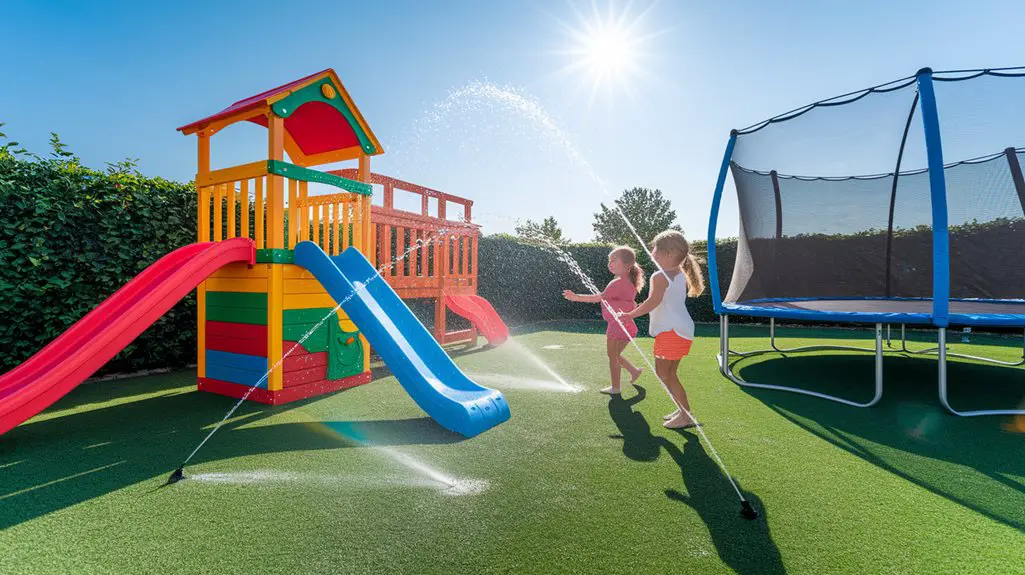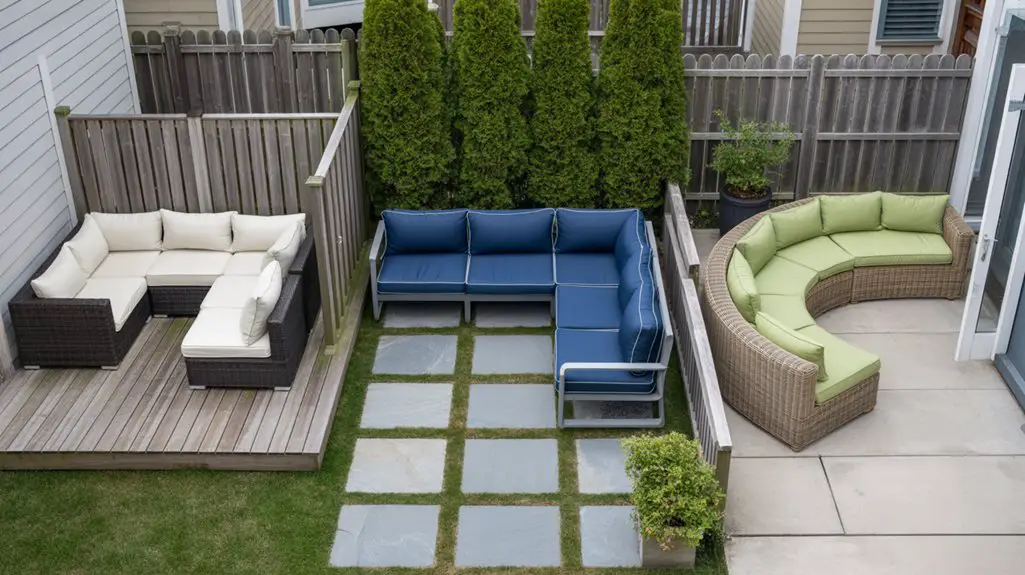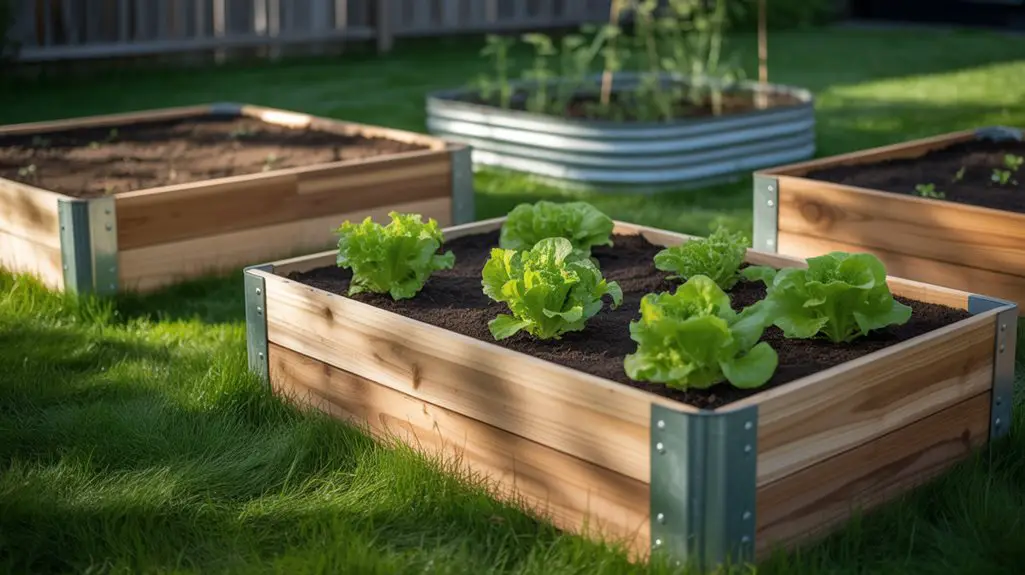Children who engage with interactive play elements spend 37% more time outdoors compared to those with static equipment. You’ll find that thoughtfully designed backyard features can transform passive recreational spaces into dynamic environments for development. Interactive elements strategically integrate sensory stimulation, physical challenges, and social opportunities while adapting to your available space and budget. The technical specifications of modern play features now allow for seamless environmental integration—but which elements will maximize your specific outdoor area’s potential?
Enhancing Physical Development Through Interactive Play
While traditional playgrounds offer standard equipment, interactive backyard features specifically designed for physical development can transform how children engage with outdoor spaces.
You’ll notice improvements in gross motor skills when you integrate adjustable climbing walls with variable handholds that adapt to your child’s growing capabilities.
Consider water-reactive surfaces that shift resistance levels, challenging developing muscles while providing sensory feedback.
These systems utilize pressure-sensitive technology that responds to weight distribution, enhancing proprioception and balance.
For ideal results, position interactive elements strategically throughout your landscape, creating movement patterns that naturally build core strength, coordination, and spatial awareness.
Modular components allow you to reconfigure challenges as your child masters skills, ensuring continuous development without outgrowing the installation.
Incorporating creative DIY ideas can also encourage imaginative play, making the outdoor space even more engaging for children.
Sensory Engagement Benefits of Interactive Features
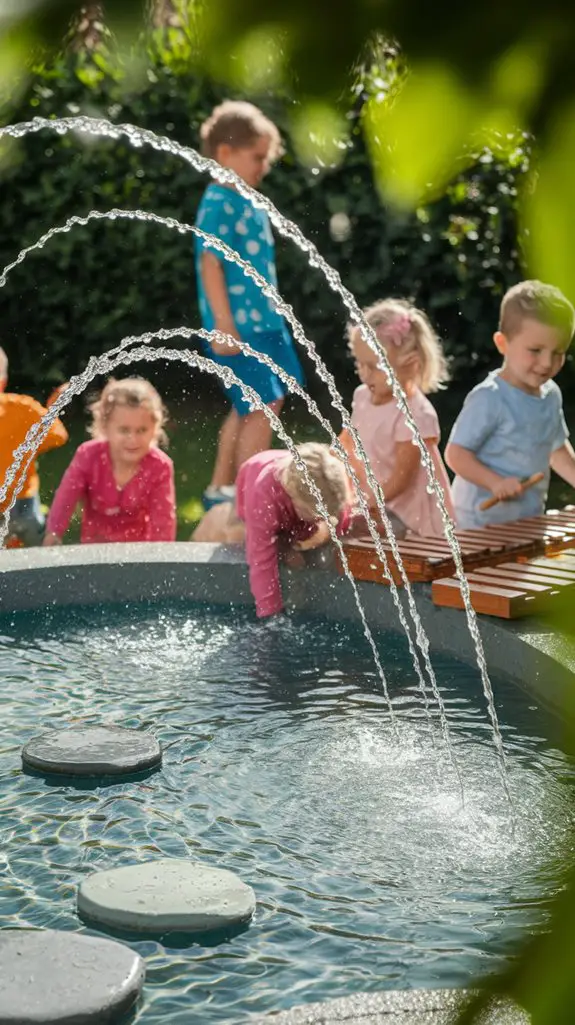
Interactive features extend beyond physical development to create rich sensory environments that actively engage all five senses. When you incorporate tactile surfaces, sound-producing elements, varied textures, and aromatic plantings, you’re crafting a multisensory landscape that stimulates cognitive development and environmental awareness.
- Water features provide auditory stimulation through gentle trickling sounds while offering tactile exploration opportunities.
- Textured pathways with alternating materials (smooth stone, bark mulch, pebbles) create foot-based proprioceptive input.
- Musical elements like chimes or drum stations encourage auditory discrimination and rhythm development.
- Aromatic garden zones with herbs and flowering plants stimulate olfactory processing and seasonal awareness.
These sensory-rich installations transform standard play areas into immersive environments that support neurological development while fostering a deeper connection to natural elements. Additionally, creating a wildlife-friendly garden not only enhances sensory engagement but also attracts beneficial creatures that contribute to a vibrant ecosystem.
Water Elements That Stimulate Learning and Fun
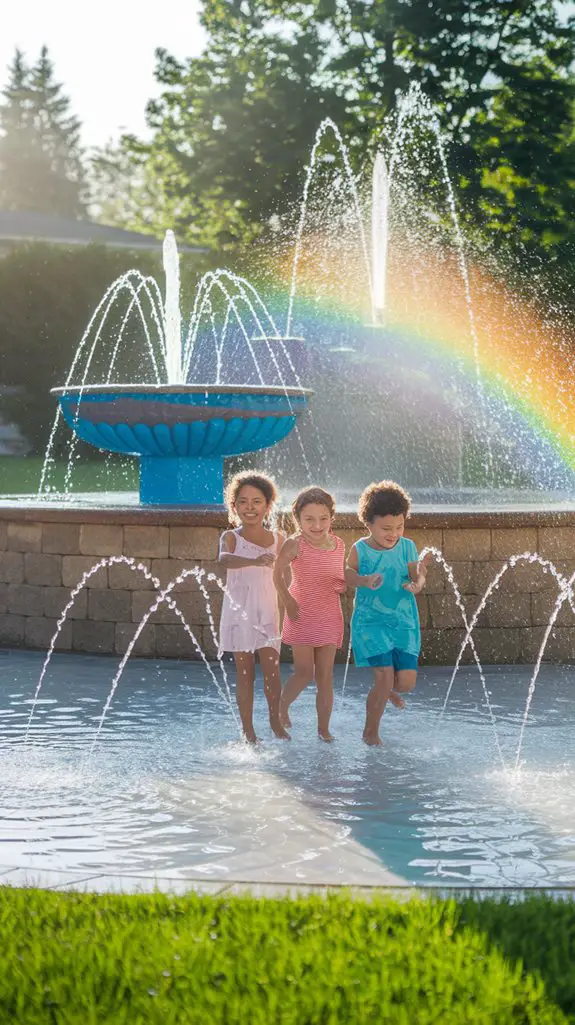
Water elements represent one of the most versatile and engaging additions to your backyard play space, transforming ordinary environments into dynamic learning laboratories. From simple rain gauges to elaborate stream tables, you’ll find these features captivate children’s attention while teaching fundamental scientific principles.
Consider incorporating stepped water channels where children can observe flow dynamics, or install a compact pump system enabling them to manipulate water movement. These hands-on experiences develop an intuitive understanding of physics concepts like gravity, momentum, and volume.
For sustainability, integrate rainwater collection systems that demonstrate conservation principles while providing play material. Position these elements strategically near permeable surfaces to manage runoff effectively. Additionally, rainwater harvesting systems can promote sustainable practices by illustrating the importance of resource conservation in a fun and interactive way.
The sound of flowing water also creates a multisensory environment, enhancing the play space’s therapeutic qualities while masking urban noise pollution.
Tech-Integrated Play Stations for Modern Children
In today’s digital landscape, thoughtfully designed tech-integrated play stations balance screen engagement with physical activity, creating dynamic learning environments for children.
You’ll find these hybrid spaces offer a seamless shift between virtual exploration and tangible outdoor experiences.
- Weather-resistant tablets embedded within climbing structures that display interactive nature identification guides
- Motion-sensitive LED pathways that respond to footsteps, encouraging movement while teaching cause-effect relationships
- Solar-powered audio stations featuring storytelling prompts that adapt based on time spent outdoors
- QR-enabled exploration zones that reveal augmented reality challenges when scanned
When designing your tech zone, prioritize weatherproof components and sustainable power sources.
Position screens at eye level with proper sun shielding to prevent glare.
Integrate technology thoughtfully, ensuring it enhances rather than replaces traditional play elements. Additionally, creating multi-age play areas fosters inclusivity and encourages social interactions among children of different ages.
Social Interaction Opportunities in Shared Play Spaces
While children navigate their developmental journey, thoughtfully designed shared play spaces become critical hubs for social skill acquisition and community building. These environments foster collaborative problem-solving when you incorporate features like multi-person seesaws, tandem swings, and interconnected climbing structures.
Consider integrating circular seating arrangements that naturally facilitate face-to-face interaction and conversation. Boundary-free zones with flexible elements allow children to negotiate space usage and develop conflict resolution skills organically.
You’ll notice increased cooperative play when your design includes stations requiring multiple participants to function properly. The spatial flow matters greatly—arrange equipment in clusters rather than linear formations to create natural gathering points.
This configuration encourages children to shift between activities while maintaining social connections, strengthening their communication abilities and emotional intelligence through sustained, meaningful interaction. Additionally, incorporating safe play equipment enhances the overall experience, ensuring that children can engage in these interactions without unnecessary risks.
Weather-Resistant Interactive Features for Year-Round Use
Creating a play space that functions effectively regardless of weather conditions requires strategic material selection and thoughtful design integration. Weather-resistant features extend usability throughout seasonal shifts while maintaining safety standards and aesthetic appeal.
- Marine-grade stainless steel components resist rust in high-humidity environments, offering longevity where standard metals would deteriorate.
- UV-stabilized HDPE (high-density polyethylene) panels maintain vibrant colors and structural integrity despite prolonged sun exposure.
- Thermally modified wood decking provides natural antimicrobial properties while resisting moisture absorption and expansion cycles.
- Drainage-optimized rubber surfacing prevents water pooling, reduces ice formation, and maintains impact absorption in temperature extremes.
You’ll find these materials complement innovative design solutions like covered activity zones, wind barriers, and shade sails—creating microclimates that protect children during play while extending your investment’s functional lifespan throughout the year. Incorporating elements such as rustic outdoor seating can further enhance the play area, promoting family engagement and comfort during outdoor activities.
DIY Interactive Elements on a Budget
Budget-friendly approaches to backyard interactivity don’t require expensive weatherproof materials to deliver meaningful play experiences.
Repurpose common household items: plastic containers become sensory stations when filled with sand, water, or natural materials. Mount chalkboards on fences at child height for creative expression zones that stimulate artistic development.
Transform fallen branches into balance beams by securing them to ground stakes. Install pulleys between trees using clothesline rope and recycled containers for physics exploration. Create musical features using suspended metal items like old pots or pipes arranged by tone.
Weather-resistant finishes like exterior latex paint or marine varnish extend the longevity of wooden elements at minimal cost.
Integrate native plants in child-accessible heights to form natural sensory stations that change seasonally, fostering environmental awareness while eliminating maintenance costs. Incorporating creative play area designs can further enhance children’s engagement and learning through play.
Safety Considerations for Interactive Backyard Features
Safety considerations must form the foundation of any interactive backyard design, regardless of how creative or engaging the features might be.
Before installing any element, assess potential hazards and integrate proper safeguards into your design specifications.
When developing interactive play features, prioritize:
- Impact-absorbing surfaces beneath climbing structures and swings—minimum depth of 9 inches for loose-fill materials like mulch or engineered wood fiber.
- Weather-resistant materials that won’t splinter, corrode, or degrade from UV exposure.
- Adequate clearance zones around moving equipment (6-foot perimeter minimum).
- Regular inspection protocols for wear points, fasteners, and structural integrity.
Always factor in your local climate conditions when selecting materials. Additionally, consider incorporating natural elements into the design to enhance the sensory experience of play.
If you’re incorporating water features, guarantee proper drainage and non-slip surfaces to prevent falls while maintaining accessibility for all users.
Customizing Interactive Zones for Multiple Age Groups
When families with children of varying ages share a backyard space, designing distinct yet interconnected play zones becomes essential for maximizing engagement and developmental benefits. You’ll need to strategically allocate space according to developmental needs while maintaining visual connections between zones. Incorporating backyard entertainment zones can enhance the overall experience for all age groups.
| Age Group | Interactive Features | Surface Type | Supervision Level | Zone Integration |
|---|---|---|---|---|
| Toddlers (1-3) | Sensory panels, sand areas | Rubberized cushioning | Constant | Adjacent to adult seating |
| Preschool (3-5) | Low climbing structures, water play | Mixed surfaces | Frequent | Central location |
| Elementary (6-9) | Modular equipment, basic challenges | Wood chips, turf | Intermittent | Connected pathways |
| Tweens (10-12) | Adventure components, skill stations | Natural surfaces | Periodic | Semi-private zones |
| Teens (13+) | Social spaces, advanced challenges | Varied terrain | Independent | Separate but visible |
Conclusion
Your backyard isn’t just outdoor space—it’s an evolutionary laboratory! By integrating interactive features, you’re creating a micro-ecosystem where your children’s development explodes exponentially. Strategically designed water circuits, tech-enhanced climbing structures, and sensory-rich stations don’t merely entertain—they’re catalyzing neural pathways while harmonizing with your landscape’s natural topography. You’re not building play equipment; you’re architecting the future through environmentally synchronized play systems that’ll transform ordinary afternoons into extraordinary developmental leaps.

